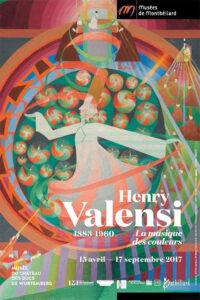Posted on April 13, 2017 in Arts & culture.
Henry Valensi exhibition at the Castle Museum of the Dukes of Württemberg
From April 15 to September 17, 2017, the museum of the castle of the Dukes of Württemberg in Montbéliard offers a retrospective of the work of Henry Valensi (1883-1960), painter of modernity on the borders of Orphism and Futurism, head of file of the Musicalist movement.
 This second retrospective since 1963 presents the story of this multifaceted artist: painter, illustrator, frequent traveler, enlightened thinker but also theorist and inexhaustible speaker. Like a conductor, Henry Valensi sets colors to music on canvas and names his most accomplished works as a symphony, a prelude or a fugue. The color and the cadence of the lines offer sentimental resonances, to the rhythm of a painting soon set in motion with his "Cinépeinture" in 1959. This exhibition, entitled The music of colors, brings a new look to this singular artist of the 2013th century , which has aroused growing interest since the Plural Modernities exhibition at the Center Pompidou in XNUMX.
This second retrospective since 1963 presents the story of this multifaceted artist: painter, illustrator, frequent traveler, enlightened thinker but also theorist and inexhaustible speaker. Like a conductor, Henry Valensi sets colors to music on canvas and names his most accomplished works as a symphony, a prelude or a fugue. The color and the cadence of the lines offer sentimental resonances, to the rhythm of a painting soon set in motion with his "Cinépeinture" in 1959. This exhibition, entitled The music of colors, brings a new look to this singular artist of the 2013th century , which has aroused growing interest since the Plural Modernities exhibition at the Center Pompidou in XNUMX.
On 500 m², the exhibition, which benefits from the precious assistance of the Association of the beneficiaries of Henry Valensi, brings together a hundred works: paintings, documents, objects, photographs and documentary films. Bringing together canvases from public collections (Center Pompidou, Musée de Grenoble, Musée des Beaux-Arts de Carcassonne, etc.), it is however mainly based on numerous loans from private collectors, and therefore makes it possible to mostly discover new works.
Born in Algiers in 1883, Henry Valensi studied painting in 1898 at the École des Beaux-Arts in Paris. Interested in the orientalist movement, he made many trips to Europe and North Africa. He was noticed in 1907 at the Salon des Indépendants in Paris. Alongside Marcel Duchamp, Francis Picabia, Albert Gleizes and Jean Metzinger, he organized the Salon de la Section d'or in 1912, the first cubofuturist salon. He thus distanced himself from realism very early on, and his research led in 1932 to the creation of the Association of Musical Artists, of which he became the main organizer and distributor to Eastern Europe for nearly twenty years.
Following a chronological journey, the exhibition is divided into four parts:
1 / 1909-1914: From Impressionism to the Golden Section
The route begins with his youthful works made during his many trips (El Kantara, Moscow, Constantinople), representing landscapes that he exhibited from 1905 at the Salon of Orientalists. In 1909, he distanced himself from impressionism. From reflections on numbers, color, rhythm and movement, the painter gave birth to the Golden Section in 1912 with his peers. His painting is therefore precisely at the crossroads between Cubism and Futurism. In 1913 he established his "Law of Prevalences", designating music as a major art of the XNUMXth century.
2 / 1915-1917: The Dardanelles campaign
The second part of the exhibition focuses on Henry Valensi's commitment as a painter to the Armed Forces during the Dardanelles expedition (1915-1916). During World War I, this region - located in present-day Turkey - was controlled by the Ottoman Empire, then at war with the United Kingdom, France and Russia. Pochades, drawings and watercolors with detailed legends are all precious historical testimonies, which he will synthesize in his immense canvas Expression des Dardanelles.
3 / 1918-1931: Dynamic movement, travel and stories
At the beginning of the 1920s, thanks to his numerous travels, Henry Valensi integrated the notion of time in space through his paintings, aiming at the synthesis of history and geography in a series of paintings paying homage to the towns crossed ( Toledo, Nice, Fez…). Movement, temporality and spatiality are also shown in series devoted to sports, entertainment and transport (bullfighting, cars, tennis, etc.), as well as to the regions of France.
4 / 1932-1960: From Musicalism to "Cinépeinture"
Henry Valensi meets Charles Blanc-Gatti, Gustave Bourgogne and Vito Stracquadaini with whom he founded Musicalism in 1932. Sentimental resonance of colors, partition in the space of the canvas ... the painting must follow the general laws of music, between rhythmic, dynamic and simultaneity. The artist gives more than 200 lectures on Musicalism, fairs are organized all over Europe and many artists join the movement. At the same time, from 1935, Henry Valensi introduced real movement into his painting with the animation of one of his paintings, the Spring Symphony, thanks to the “Cinépeinture”. He made a 28-minute short film alone with more than 64 drawings, which he completed in 000.
An exhibition catalog of around a hundred pages was published on this occasion by the Montbéliard Museums. Reproducing numerous paintings by Henry Valensi, it is also decorated with the Manifesto of Musicalism as well as unpublished texts by Caroline Hancock and Aurélie Voltz.
The exhibition will finally be complemented by a rich program of events spanning several months, including conferences, meetings and concerts in collaboration with the Conservatoire de Musique de Montbéliard.
Pratical information
Castle Museum of the Dukes of Württemberg
25200 Montbeliard
03 81 99 22 61
museums@montbeliard.com
www.montbeliard.fr
Exhibition from April 15 to September 17, 2017
10 a.m. to 12 p.m. and 14 p.m. to 18 p.m.
Closed Tuesdays and holidays
Entrance : 5 euros / Group and student rate: 3 euros
Free entry for children under 18, disabled people, as well as the 1st Sunday of each month.
Opening April 14 at 18 p.m.
Curator of the exhibition: Aurélie Voltz, director of the Montbéliard Museums, assisted by Sarah Guilain.
Drawing Now Art Fair: Tatiana Wolska winner 2024
The invention of language by Gertrude Stein and Pablo Picasso
The history of French women's golf at Golf du Sorbier








